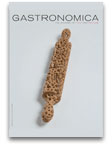
Edible Media takes an occasional look at interesting or deplorable food journalism on the web.
Anyone who loves food, and enjoys reading about it, should check out the quarterly magazine Gastronomica, which calls itself the “journal of food and culture.”
It’s published by the University of California Press, but it’s no academic rag. It tends to print quirky, passionate essays — on luxurious paper stock, with loads of lovely photos — by all manner of writers: cooks, poets, farmers, and food scholars.
In the current issue — available online only for a stiff fee, but soon to be on newsstands and in libraries — there’s an article by me. It’s a review of two recent cookbooks arguing that if we must eat meat, we should embrace the “whole beast,” and not just filets, breasts, and other “center cuts.”
I’ve been reading Gastronomica since its very first issue in 2001 — back when I was a frustrated finance writer wondering how I was ever going to break into food journalism. So it’s very gratifying to see my name alongside those of people I’ve learned much from over the years.
The current issue is packed with good stuff, but there are three writers in particular with whom I am proud and daunted to share a table of contents:
* Clifford A. Wright, “The Spice Trade and the Diffusion of the Chile.” Wright is one of our best cookbook writers on the Mediterranean region — and a wonderful popular scholar. His book A Mediterranean Feast doubles as an encyclopedic cookbook and a kind of people’s history of an area that typically gets swathed in nostalgic mist by the U.S. food press.
“Consider that until recently the picture of the Mediterranean was one of poverty and destitution, even in the richest countries,” Wright writes. “[Modern] Mediterranean cuisines developed as a reaction against the monotonous foods of centuries of famine and starvation.” Not a perspective you’re likely to get in, say, the latest Wine Spectator spread on southern France.
* Nancy Harmon Jenkins, “Two Ways of Looking at Maestro Martino.” Jenkins, too, has made her reputation writing about the Mediterranean, but her particular specialty is Italy. Like Wright, she rejects glorious-Mediterranean cliches and gets to the heart of the matter. I was once lucky enough to spend some time in Puglia, the state that forms of the heel of Italy’s boot. When I returned to the U.S., I devoured Jenkins’ Flavors of Puglia, about a place where cooks know how to turn a few ingredients, using not much meat at all, into something amazing.
* Mary Taylor Simeti, “At the Prince’s Table: Food in the Leopard.” Simeti is the foremost English-language authority on the food of Sicily. In the blazing-hot summer of 2003, I had the great fortune to visit her at her farmhouse near Palermo, through a connection with a family friend.
Simeti and her family run a small organic farm that produces wine grapes, olive oil, and vegetables. I was a completely obscure writer trying to make the transition into food, yet Simeti spent hours talking with me in the coolness of her farmhouse cellar. I had a lunch I’ll never forget with Simeti and her family, from vegetables Simeti herself snipped from her garden and transformed into a simple pasta sauce — washed down with inky, concentrated wine her husband had made from Nero D’Avola, Sicily’s native grape.
That afternoon exerts an influence over my life still ripples today.
And so does the influence of Gastronomica. I’m both proud and humbled to have published there.

